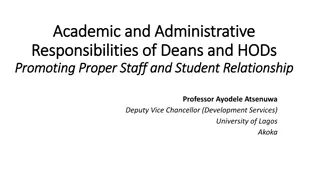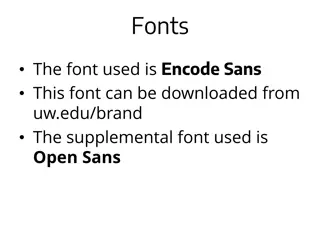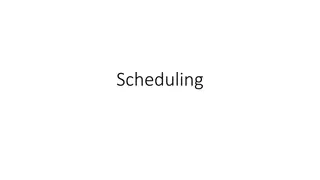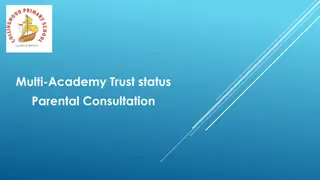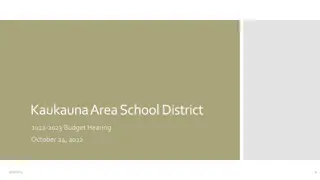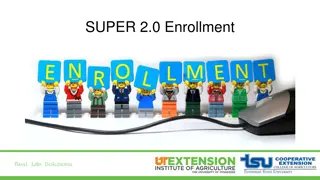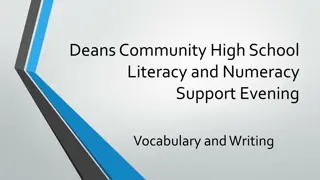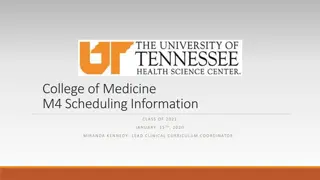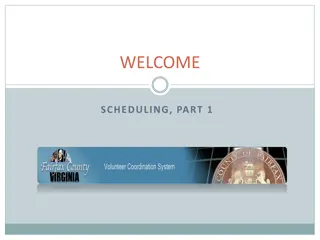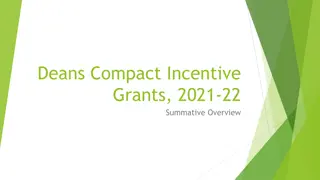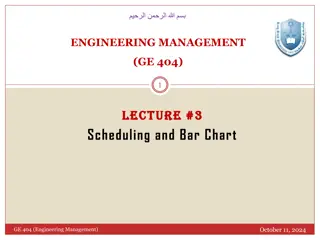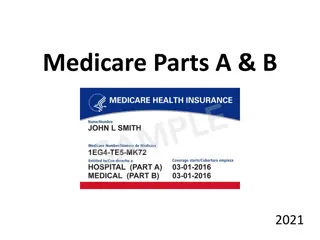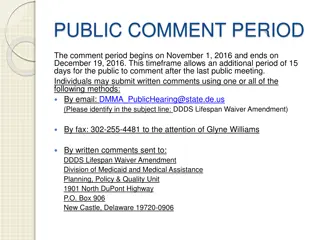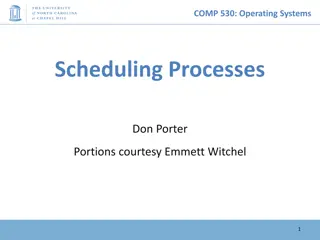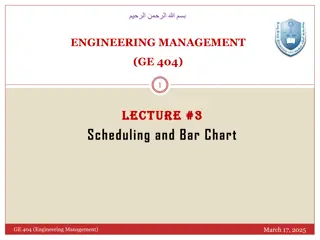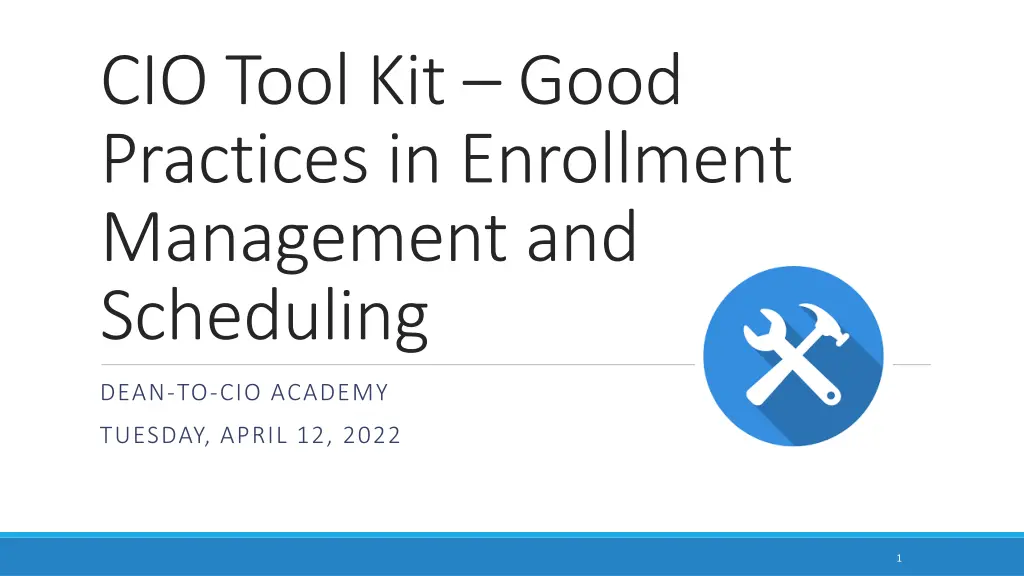
Efficiency and Best Practices in Enrollment Management and Scheduling
Join the DEAN-TO-CIO ACADEMY on April 12, 2022, for a knowledge-packed session on top drawer tools, balancing class sizes, attendance accounting, and more. Senior administrators and college presidents present valuable resources and insights to enhance productivity and efficiency in community colleges.
Download Presentation

Please find below an Image/Link to download the presentation.
The content on the website is provided AS IS for your information and personal use only. It may not be sold, licensed, or shared on other websites without obtaining consent from the author. If you encounter any issues during the download, it is possible that the publisher has removed the file from their server.
You are allowed to download the files provided on this website for personal or commercial use, subject to the condition that they are used lawfully. All files are the property of their respective owners.
The content on the website is provided AS IS for your information and personal use only. It may not be sold, licensed, or shared on other websites without obtaining consent from the author.
E N D
Presentation Transcript
CIO Tool Kit Good Practices in Enrollment Management and Scheduling DEAN-TO-CIO ACADEMY TUESDAY, APRIL 12, 2022 1
Dr. Jennifer Zellet Modesto Junior College President-Elect, East Central Region 5 Presenters Dr. Brian Sanders Columbia College Treasurer, East Central Region 5 2
1. Top Drawer Tools Session Overview 2. Efficiency/Productivity & The Handy- Dandy Class Size Balancing Machine 3. Attendance Accounting & Scheduling 4. If time allows: Stump the Teacher (Exploring your favorite scheduling insanities!) 3
Administrators Top Drawer Tools 1. Student Attendance Accounting Manual 2. Program and Course Approval Handbook 3. Minimum Qualifications for Faculty and Administrators in California Community Colleges 4. Westlaw s California Code of Regulations Title 5 5. California Education Code 6. Chancellor s Office Curriculum and Instruction Unit 7. The Course Outline of Record: A Curriculum Reference Guide Revisited ASCCC, Spring 2017 8. Data Element Dictionary in MIS area of CCCCO Website 4
Efficiency/Productivity and the Handy-Dandy Class Size Balancing Machine AN OBJECT LESSON IN THE CIO LOCUS OF CONTROL AND THE IMPACT OF 1000 SMALL DECISIONS 5
The Typical CIO Charge Improve Productivity, a.k.a. Improve Instructional Efficiency Productivity or Efficiency is basic economics a revenue to expense ratio Revenue comes from classes via apportionment (FTES) Expense comes most directly from paying the instructor Three options The grandparent WSCH 1. FTEF The teenager FTES 2. FTEF The newcomer FTES 3. aFTEF where aFTEF is annual class load, e.g. 3-unit lec is 10% of annual load. 6
The Typical CIO Charge Improve Productivity/Improve Instructional Efficiency They are mathematically equivalent constant multiples of each other but they feel different. The grandparent WSCH 1. FTEFProtypical value for an efficient college 525 The teenager FTES 2. FTEFProtypical value for an efficient college 17.5 The newcomer FTES 3. aFTEFProtypical value for an efficient college 35 WSCH FTEF = 30 x FTES FTEF = 15 x FTES 4. aFTEF The newcomer FTES 5. aFTEFrepresents weighted average class size which everyone can feel. 7
PRODUCTIVITY TARGETS Locus of Control & Points of Maximal Impact CIO S LOCUSOF CONTROLON PRODUCTIVITY CIO S POINTSOF MAXIMAL IMPACTON PRODUCTIVITY Local practice College or District Schedule Planning with Deans Local policy College or District Productivity Targets Accreditation expectations Low Enrollment/Cancellation Guidelines Accreditation requirements Deans & Faculty Schedule development/publishing State guidelines for practice State regulations Actual Student Demand State laws Class Cancellations Federal regulations and/or laws 8
The Handy-Dandy Class Size Balancing Machine An object lesson and discussion 9
CIO is responsible to move the overall college value Section Level View (almost 1600 sections) 1.5 1 College-wide value 32.2 0.5 0.00 5.00 10.00 15.00 20.00 25.00 30.00 35.00 40.00 45.00 Productivity (FTES/annualizedFTEF) 50.00 55.00 60.00 65.00 70.00 75.00 80.00 85.00 90.00 95.00 100.00 105.00 110.00 115.00 120.00 10
CIO is responsible to move the overall college value Department-Level Balancing 1.5 1 College-wide value 32.2 0.5 10.00 15.00 20.00 25.00 30.00 35.00 40.00 45.00 50.00 55.00 60.00 65.00 70.00 Productivity (FTES/annualized FTEF) 11
CIO is responsible to move the overall college value Division-Level Balancing 1.5 Social Sciences Arts&Comm Language Arts Business Allied Health Public Safety 1 Guide&Library PE Ag&Tech STEM College-wide value 32.2 0.5 15.00 20.00 25.00 30.00 Productivity (FTES/annualizedFTEF) 35.00 40.00 45.00 50.00 55.00 12
aFTEF = annualized FTEF = % of annual load. E.g. 3-unit lec = 10% of annual faculty load. Columbia College Productivity Targets A&S Lecture only classes = 32 FTES/aFTEF Arts & Sciences Division = 30 FTES/aFTEF A&S Lecture- Lab classes = 28 FTES/aFTEF Columbia College = 28 FTES/aFTEF CTE Lecture- Lab classes = 28 FTES/aFTEF CTE Division = 26 FTES/aFTEF CTE Lab only classes = 24 FTES/aFTEF COLLEGE-WIDEAND DIVISION-LEVELTARGETSAREEXPECTEDOFTHE DEANS. CLASS-LEVELTARGETSSHOWNAREFORILLUSTRATIONONLYINTHIS DIAGRAM. DIVISIONSAREASKEDTOSETANDPURSUEDEPARTMENT-LEVELTARGETSINSUPPORTOFDIVISION- ANDCOLLEGE-LEVELTARGETS.
More Complex Model College = 35 FTES/aFTEF Allied Health 18 Arts & Comm 35 Language Arts 26 Social Science 41 Business 32 CTE 24 PE 35 STEM 37 Art Hist 45 Art Studio 29 Music Apprec 45 Music Perf 14 Comm 32 Astro 45 Bio 36 Chem 28 Math 38 Physics 25
Interactive Moment Sketch your own Productivity Targets Diagram College = # FTES/aFTEF Division ## Dept # 15
Attendance Accounting & Scheduling FUNDAMENTALS, EXAMPLES, CASE STUDIES, AND CALCULATIONS FOR YOUR OWN DISTRICT 16
Full-Time Equivalent Student (FTES) Factors in FTES calculation Clock Hour vs Class Hour Passing Time and Break Time Partial Class Hour Multiple Hour Class Attendance Accounting Methods Weekly Student Contact Hour Daily Student Contact Hour Actual Hours of Attendance (positive attendance) Independent Study and Work Experience Noncredit Distance Education Section Overview 17
Use your Tools Student Attendance Accounting Manual What is a Full Time Student? What is an FTES? WHY? Full Time Student for purposes of Financial Aid 12 or more units What s the fatal flaw in this logic? 1 FTES = 525 contact hours Open Student Attendance Accounting Manual. Search for 525 . Answer the Why? 525 = 15 x 35 18
Full-time equivalent student (FTES) 1 FTES = 1 student 15 hours per week 2 semesters of 17.5 weeks = 525 student contact hours A full-time student is in class 15 hours a week (full load) for 1 full year (35 weeks). 19
Interactive Moment Determine FTES for a single student s unit load Determine two different configurations of classes that add up to your assigned total units using the table provided. Determine total contact hours in a traditional calendar district (17.5 hrs/lec unit) Calculate the amount of FTES for each option Ex: 14 unit load Lec Units Lab Units Lec Hours Lab Hours Total Hours Class Units FTES Psych 3 3 0 52.5 0 52.5 0.1 Does this make sense? Bio 4 3 1 52.5 52.5 105 0.2 Art 2 1 1 17.5 52.5 70 0.1333 How much of an FTES is a FT student? PE 1 0 1 0 52.5 52.5 0.1 Math 4 4 0 70 0 70 0.1333 Total 14 11 3 192.5 157.5 350 0.6667
Factors in FTES calculation Clock hour vs Class Hour Clock Hour A 60-minute time frame Class Hour A period of not less than 50 minutes of scheduled instruction There can be only one class hour in each clock hour, except as provided for multiple hour classes A class hour is commonly called a student contact hour 21
Factors in FTES calculation Passing Time and Break Time Each clock hour is composed of one class hour segment and a segment referred to as passing time or break time Think: Bio break! No additional attendance may be claimed for the 10-minute segment, except for multiple hour classes The 10-minute break time permitted in each clock hour may not be accumulated during a multi-hour block scheduled class to be taken all at once at the end of class and be counted for FTES purposes. 22
Factors in FTES calculation Partial Class Hour A "partial class hour" is that fractional part of a class hour in a class scheduled for more than one clock hour A partial class hour is always taken in conjunction with a full class hour, becoming a Multiple Hour Class 23
Factors in FTES calculation Multiple Hour Class Any period of instruction scheduled continuously for more than one clock hour Each 50 minutes exclusive of breaks is a class/contact hour A fractional part of a class hour beyond the last full clock hour is counted from the 51st minute of the last full clock hour No class break is allowed in the last full clock hour or the partial class hour The divisor for this fractional part of a class hour is 50. 24
Factors in FTES calculation Multiple Hour Class Calculation example 1 8:00 am to 9:25 am 1 full contact hour 8-8:50 Partial Class Hour 8:51 9:25 = 35 min 35/50 = 0.7 Total Contact Hour = 1.7 Because single session is less than 95 minutes, there is no break time 25
Factors in FTES calculation Multiple Hour Class Calculation example 2 7:00 pm to 10:05 pm Two full contact hours 7:00-9:00 Includes 20 min break time 10 min in first hour 7:50-8:00 10 min in second hour 8:50-9:00 Last Class Block (incl partial class hour) 9:00 10:05 = 65 min 65/50 = 1.3 No break from 9:00-10:05 because less than 95 min Total Contact Hours = 3.3 26
Factors in FTES calculation Calculate Contact Hours Class meets from 0800 to 0850 0800 to 0900 0800 to 0905 0800 to 0950 0800 to 1000 0800 to 1005 0800 to 1030 0800 to 1225 Contact Hours 1.0 1.0 1.3 2.0 2.0 2.3 2.8 4.7 Breaks None None None One 10-min One 10-min One 10-min One 10-min Three 10-min 27
Hrs Min # Bk Bk Min 0 0 0 0 0 0 0 0 0 0 10 10 10 10 10 10 10 10 10 10 10 10 20 20 20 Hrs Min # Bk Bk Min 20 20 20 20 20 20 20 20 20 30 30 30 30 30 30 30 30 30 30 30 30 40 40 40 1.0 1.0 1.0 1.3 1.4 1.5 1.6 1.7 1.8 1.9 1.9 1.9 2.0 2.0 2.0 2.3 2.4 2.5 2.6 2.7 2.8 2.9 2.9 2.9 3.0 50 55 60 65 70 75 80 85 90 95 100 105 110 115 120 125 130 135 140 145 150 155 160 165 170 0 0 0 0 0 0 0 0 0 0 1 1 1 1 1 1 1 1 1 1 1 1 2 2 2 3.0 3.0 3.3 3.4 3.5 3.6 3.7 3.8 3.9 3.9 3.9 4.0 4.0 4.0 4.3 4.4 4.5 4.6 4.7 4.8 4.9 4.9 4.9 5.0 etc. 175 180 185 190 195 200 205 210 215 220 225 230 235 240 245 250 255 260 265 270 275 280 285 290 2 2 2 2 2 2 2 2 2 3 3 3 3 3 3 3 3 3 3 3 3 4 4 4 Key to Hours Calculations 50 min + 10-min break + 50 min + 10-min break + final session up to 95 minutes without a break Example: 190 min = 3.4 apportionment hours is calculated this way: 50 min class + 10 min break = 1st 60-min hr = 1.0 appt hr 50 min class + 10 min break = 2nd 60-min hr = 1.0 appt hr Final 70-min session with no breaks = 1.4 appt hrs Total = 3.4 appt hrs 28
Interactive Moment Determine contact hours. Class meets 1. Tuesdays from 6:00 pm to 8:50 pm 2. Tuesdays from 6:00 pm to 9:00 pm 3. Tuesdays from 6:00 pm to 9:05 pm 4. Monday & Wednesday from 8:00 am to 10:30 am 5. Monday from 12:00-1:05 pm for lecture and Wednesday from 3:00-6:05 pm for lab 6. Monday & Wednesday from 9:00 to 10:00 am for lecture then from 10:00 am 1:00 pm for lab. 7. Thursday morning from 8:00-8:30 am for lecture then from 8:30 am to 2:30 pm for lab. 29
Attendance Accounting Methods Only options in Student Attendance Accounting Manual 1. Weekly Student Contact Hour Procedure (Weekly Census) 2. Daily Student Contact Hour Procedure (Daily Census) 3. Actual Hours of Attendance Procedure (Positive Attendance) 4. Alternative Attendance Accounting Procedure Credit Includes most DE plus independent study and work experience 5. Alternative Attendance Accounting Procedure Noncredit 30
Attendance Accounting Methods Weekly Student Contact Hour Procedure Primary terms only (fall/spring) Class is coterminous with primary term Meets regularly every week Same number of hours each week including TBA hours No deduction for holidays (i.e. holidays are forgiven ) 31
Attendance Accounting Methods Census Week - WSCH The week nearest to 20% of the number of weeks in the term Census date is on Monday of census week Except if Monday is a holiday, then census date is the following day 32
Attendance Accounting Methods Term Length Multiplier (TLM) TLM is the number of weeks in a primary terms with at least three days of instruction The TLM for each college is set by the Chancellor s Office based on the college s academic calendar Maximum TLM: 17.5 for semesters TLMs for 2019-2020 (CCCCO.edu: search for term length multiplier ) Interactive moment: Find your TLM! Find the TLMs of your neighbors. 33
Attendance Accounting Methods Over-Arching FTES Formula (census-based) N = Number of students enrolled at census TSCH = Total Student Contact Hours (aka Term Student Contact Hours) = Number of hours each student spends in class for the term FTES = TSCH N 525 Ex: 40 students in a class with 52.5 total contact hours with each student FTES = 52.5 40 525 = 4.00 34
Attendance Accounting Methods FTES Calculation for Weekly Census TSCH = Weekly Student Contact Hours x TLM. N=Census enrollment FTES = TSCH N =(WSCH TLM) N 525 525 Ex 1: 40 students in a class meeting 3 hours/week and TLM=17.5 FTES = (3 17.5) 40 525 = 4.00 Ex 2: 25 students in a class meeting 6 hours/week and TLM = 16.4 FTES = (6 16.4) 25 525 = 4.69 35
Interactive Moment Determine Total Student Contact Hours (Weekly Method) 1. Class meets Tuesdays from 6:00 pm to 8:50 pm (TLM = 17.5). 2. Class meets Tuesdays from 6:00 pm to 9:05 pm (TLM = 16.4). 3. Class meets Monday & Wednesday from 8:00 am to 10:30 am (TLM = 16.8). 36
Working backwards from Course Outline of Record Determine Course Hours to Schedule Example 3-unit lec in 16.4-week term meeting twice per week 1. Get the expected hours from the Course Outline of Record 54 3.2927 2. Divide by the TLM to get hours per week 1.6463 3. Divide by the number of meetings per week to get hours per session 1.7 4. Round UP to the nearest tenth of an hour clear 5. Watch out for gray areas! 1.7 x 2 x 16.4 = 6. Check your math. Hrs/session x # sessions/wk x TLM. 1. How many hours did you end up with? 2. What is that as a percent of your COR hours? (% of Target = scheduled hrs / COR hrs) 55.76 55.76/54 = 1.033 = 103% 1. 16 hours of lecture + 32 hours outside class per unit 32 hours of activity + 16 hours outside class per unit 48 hours of laboratory unit 7. Good practice: 1. Exceed the hours on the COR by the least amount possible. 2. Aim for 100-105% of COR hours 3. You can schedule below the target but must meet or exceed minimums in Title 5 55002.5 2. 3. 37
Interactive Moment Determine Class Length and % of Target 1. Class needs 52.5 contact hours with two meetings per week (TLM=17.5) How long is each session? What is your percent of target hours? 2. Class needs 90 contact hours with two meetings per week (TLM=16.8) How long is each session? What is your percent of target hours? 3. Class needs 72 contact hours with four meetings per week (TLM=16.4) How long is each session? What is your percent of target hours? 38
Attendance Accounting Methods Daily Student Contact Hour (DSCH) Class meets five or more days Meets regularly: the same number of hour on each scheduled day, including any TBA hours NOT coterminous with primary term Always used in summer, winter, and partial terms (e.g. first 8 weeks, last 8 weeks, late-start 12-week classes) No hours counted for holidays (i.e. holidays not forgiven ) Option A: College loses those contact hours. Beware T5 min hrs! Option B: Extend class hours to cover missing holidays. 39
Attendance Accounting Methods Census Day - DSCH The day of the class meeting that is nearest 20% of the number of days the course scheduled to meet When census day falls on the first day the class meets, census is taken on the second day 40
Attendance Accounting Methods Course Length Multiplier (CLM) CLM is the number of days the course is scheduled to meet That is, the number of class meetings 41
Attendance Accounting Methods FTES Calculation for Daily Census TSCH = DSCH x CLM. N = Census Enrollment FTES = TSCH N 525 =(DSCH CLM) N 525 Ex 1: 40 students in a class meeting 2 hours/day for 20 days FTES = (2 20) 40 525 = 3.05 Ex 2: 30 students in a class meeting 8:00-12:30 M-F for four weeks, with one holiday FTES = (4.8 19) 30 525 = 5.21 42
Interactive Moment Determine Total Student Contact Hours (Daily Method) 1. Class meets M-Th for 5 wks minus 1 holiday from 8:00 am to 10:30 am. Find term hrs. 2. Class meets 8 Monday nights from 6:00 pm to 9:35 pm. Find term hrs. Trick question! 3. Monday from 12:00-1:05 pm for lecture and Wednesday from 3:00-6:05 pm for lab for 6 weeks. No holidays. 4. Class needs 52.5 contact hours with two meetings per week over 6 weeks. No holidays. How long is each session? What is your percent of target hours? 5. Class needs 90 contact hours with four meetings per week for 10 weeks with one holiday. How long is each session? What is your percent of target hours? 6. Class needs 36 hours of lecture and 108 hours of lab with 19 class meeting sessions, when holidays are removed. How do you schedule it? 43
Attendance Accounting Methods Actual Hours of Attendance (Positive Attendance) Based on actual count of enrolled students present at each class meeting Courses meeting fewer than five days Courses irregularly scheduled for the number of days per week (full term) or number of hours on scheduled days (short term) All face-to-face noncredit courses Open entry/open exit courses Calculation: divide the total hours of actual attendance by 525 44
Attendance Accounting Methods Alternative Attendance Accounting One student contact hour shall be counted for each unit of credit for which the student is enrolled as of the census date or day using a standardized 17.5 TLM TSCH = Units x 17.5. N = Census enrollment. FTES = TSCH N =(Units 17.5) N 525 525 Ex: 3-unit online Psych 101 with 40 students FTES = TSCH N 525 =(3 17.5) 40 525 45
Interactive Moment What s wrong with this example? 4-unit Biology with lab for nonmajors, 28 students enrolled TSCH = Units x 17.5. N = Census enrollment. FTES = TSCH N =(Units 17.5) N 525 525 FTES = TSCH N =(4 17.5) 28 525 = 3.73 525 46
Attendance Accounting Methods Alternative to the Alternative Attendance Accounting Hot off the presses! (In Sept/Oct 2021) Revised T5 58009, CCCCO Memo FS 21-12 If the online class includes laboratory then districts should claim the equivalent number of hours that would be generated in a face-to-face laboratory course that corresponds to traditional length (non- compressed) primary terms, using the standardized 17.5 TLM. 47
Attendance Accounting Methods Alternative to the Alternative Attendance Accounting In practice, unless your district allows extra hours on the COR, this becomes the simple formula: FTES = TSCH N =[ Lec Units 17.5 + Lab Units 52.5 ] N 525 525 Ex: 4-unit Bio, with 3 units lec and 1 unit lab, 28 students FTES = [ 3 17.5 + 1 52.5 ] 28 525 = [52.5+52.5] 28 525 = [105] 28 525 = 5.6 48
Our Old Opposition to Creative Scheduling Scheduling creatively, e.g. alternating weekends, results in Irregular Scheduling Irregular Scheduling forces use of Positive Attendance Accounting Positive Attendance is a pain and we lose money We should avoid Positive Attendance Online components force Alternative Attendance Accounting Alternative Accounting penalizes colleges, losing 9% of their FTES Therefore alternative is bad and to be avoided Therefore let s stick to Weekly and Daily. Skip those creative scheduling options! They re too hard 49
Our New Strategy for Creative Scheduling Scheduling creatively, e.g. alternating weekends, results in Irregular Scheduling Irregular Scheduling forces use of Positive Attendance Accounting Positive Attendance is a pain and we lose money We should avoid Positive Attendance Online components force Alternative Attendance Accounting Alternative Accounting penalizes colleges, losing 9% of their FTES Therefore alternative is bad and to be avoided Online penalty has mostly ended (e.g. get 52.5 hrs for a 54-hour class now, vs 49) Online supersedes Irregular, so Alternative supersedes Positive Attendance Let s EXPAND creative scheduling and intentionally INCLUDE Therefore let s stick to Weekly and Daily. Skip those creative scheduling options! They re too hard online components to FORCE Alternative Accounting and generate, in effect, pay-per-unit And after COVID, we can t envision creative solutions that do not involve some online learning! 50

